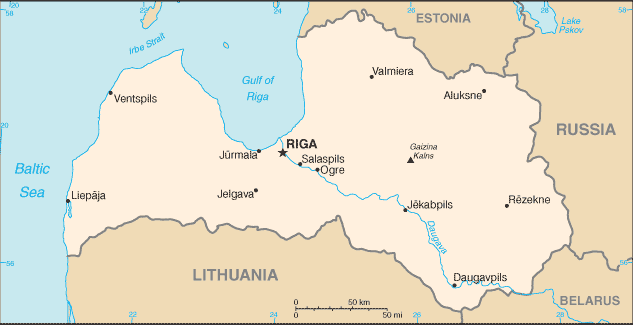|
Latvia
|

|
Capital: Riga
Population: 1,906,743
Brief History of Latvia:
Latvia was originally settled by Baltic tribes. The Baltic tribes had formed their own local governments by the 10th century. In the 11th century Germany began to have influence on the land. In 1201 it was the German Bishop Albert of Livonia who established the city of Riga, which is today the capital of Latvia. Germany mostly controlled the area of Latvia for the next 500 years.
In 1721 Russia took control over Latvia. It wasn't until the late 1800s and early 1900s until Latvia began to promote its own identity. In 1918 Latvia declared its independence. In 1921 it became a member of the League of Nations.
During World War II, the Germans occupied much of Latvia. Many Latvian Jews were killed by the Germans. It is thought that almost one third of the Latvian population was killed by Germans and the Russians during the war. After the war, Latvia was taken over by the Soviet Union. The Soviet Union changed Latvia dramatically, deporting native Latvians to other areas of the Soviet Union and immigrating Soviets into the country.
In 1991, with the collapse of the Soviet Union, Latvia became an independent country. In 2004 it joined the European Union.
The Geography of Latvia
Total Size: 64,589 square km
Size Comparison: slightly larger than West Virginia
Geographical Coordinates: 57 00 N, 25 00 E
World Region or Continent: Europe
General Terrain: low plain
Geographical Low Point: Baltic Sea 0 m
Geographical High Point: Gaizinkalns 312 m
Climate: maritime; wet, moderate winters
Major cities: RIGA (capital) 711,000 (2009)
The People of Latvia
Type of Government: parliamentary democracy
Languages Spoken: Latvian (official) 58.2%, Russian 37.5%, Lithuanian and other 4.3% (2000 census)
Independence: 21 August 1991 (from Soviet Union)
National Holiday: Independence Day, 18 November (1918); note - 18 November 1918 is the date Latvia declared itself independent from Soviet Russia; 4 May 1990 is when it declared the renewal of independence; 21 August 1991 is the date of de facto independence from the Soviet Union
Nationality: Latvian(s)
Religions: Lutheran, Roman Catholic, Russian Orthodox
National Symbol: white wagtail (bird)
National Anthem or Song: Dievs, sveti Latviju! (God Bless Latvia)
Economy of Latvia
Major Industries: buses, vans, street and railroad cars; synthetic fibers, agricultural machinery, fertilizers, washing machines, radios, electronics, pharmaceuticals, processed foods, textiles; note - dependent on imports for energy and raw materials
Agricultural Products: grain, sugar beets, potatoes, vegetables; beef, pork, milk, eggs; fish
Natural Resources: peat, limestone, dolomite, amber, hydropower, wood, arable land
Major Exports: wood and wood products, machinery and equipment, metals, textiles, foodstuffs
Major Imports: machinery and equipment, chemicals, fuels, vehicles
Currency: Latvian lat (LVL)
National GDP: $34,890,000,000
** Source for population (2012 est.) and GDP (2011 est.) is CIA World Factbook.
Back to Geography Home Page
